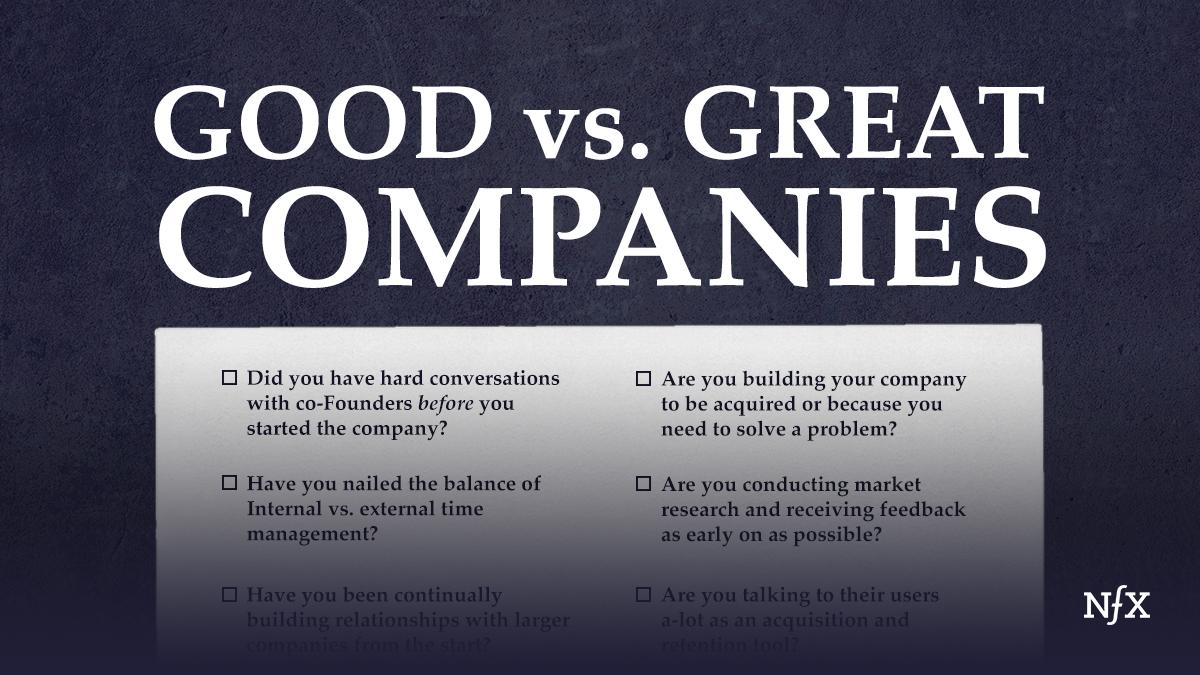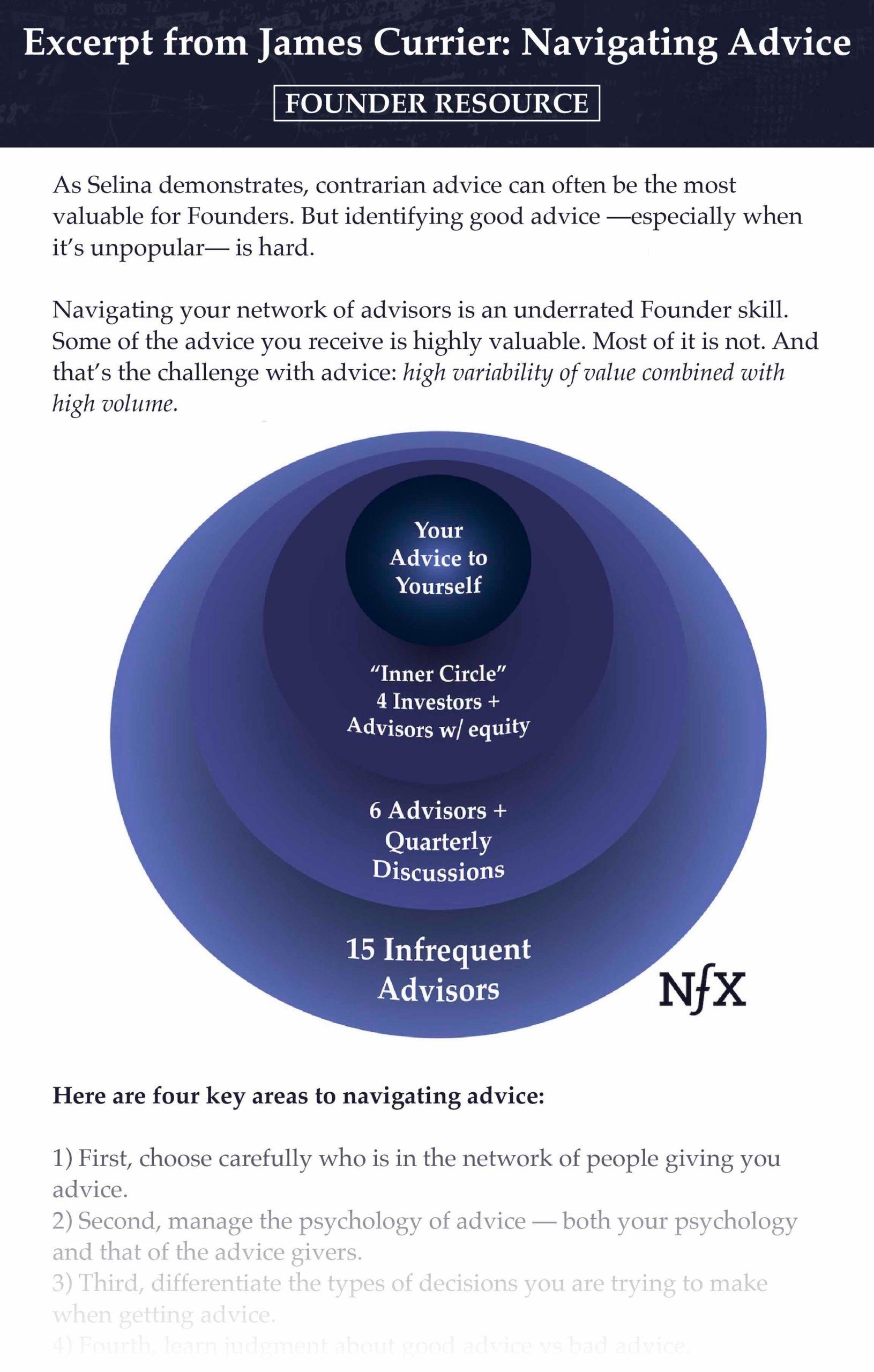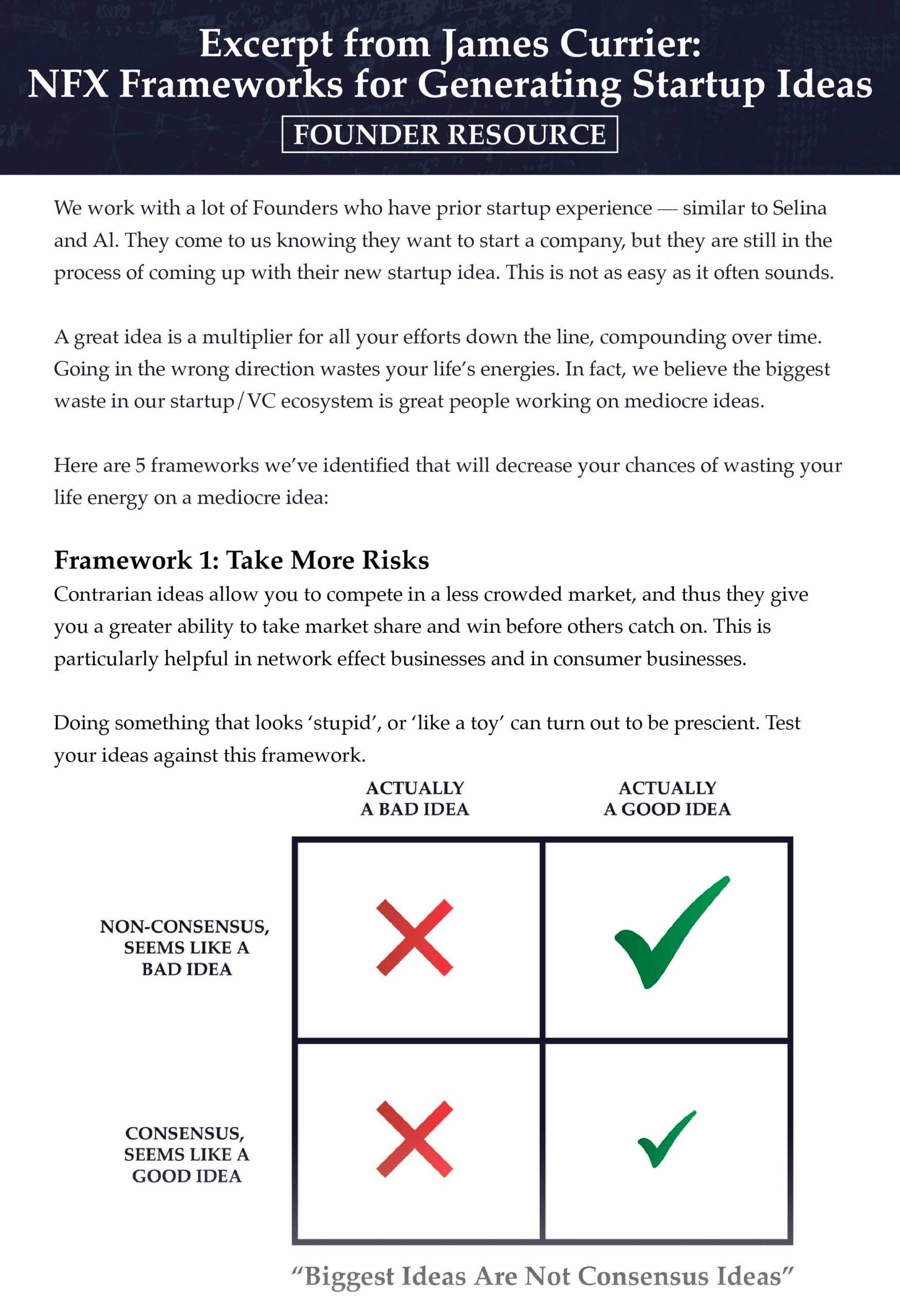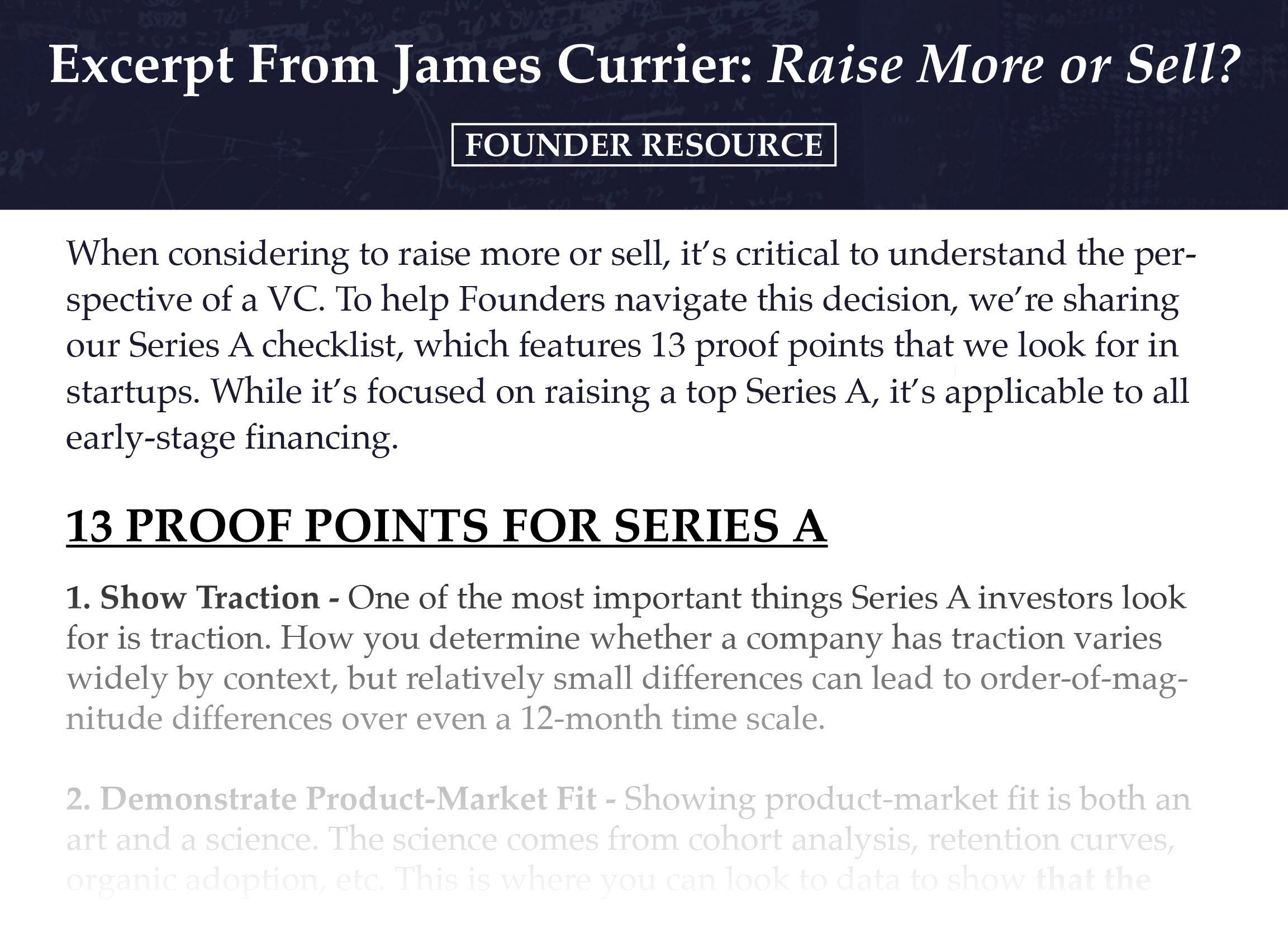

For early-stage Founders, it’s rare to get a candid view into what happens behind the scenes of companies that break out from the pack. What’s clear is that successful Founders operate differently. Sometimes in large ways, but often in small nuances that tip the scales of success.
Even more rare is hitting that kind of success twice. As my friend Sarah Lacy titled her book, “Once You’re Lucky, Twice You’re Good.”
In this NFX podcast and essay, we get a look inside these kinds of companies and Founders with Selina Tobaccowala. As the co-founder of Evite (sold to IAC), CTO and President of SurveyMonkey, and then cofounder of Gixo (sold to Openfit), she has built companies that have shaped a generation of products and been used the world over.
We talk about the tipping point from good to great in early-stage companies, covering co-founder dynamics, hard conversations, managing risk, raising VC, selling your company, and starting again.
There are always outliers, but these are the things we’ve both found that often separate the good companies from the truly great ones.
Let’s jump in.
Great Founders have these hard conversations with co-Founders before they even start.
- One thing I tell cofounders when they’re just starting: There are certain tenets you should agree on upfront. Including how and when you would sell.
- Ultimately when those hard decisions come — whether it’s an offer on the table, or you’re dealing with an employee issue, or you’re trying to figure out how much funding to take — you have already established some of that base level conversation. You need to practice actually having that dialogue and having that conversation so that you can have that honesty, and you can have that rapport when you’re actually walking into it.
- Because later when you’re trying to make those hard decisions — taking or leaving an offer, letting go of an employee who is a human being — it’s much harder to make those decisions in the heat of the moment if you haven’t established some of your base principles. You need to do that before you actually start.
- Al Lieb and I paired up in our third year at Stanford (which was his final year and my junior year) to start Evite. Then we got together again to found Gixo over a decade later. In between, I had been CTO and then president of Survey Monkey. Al had founded ClearSlide. Our experience in 2016 was completely different from 1997 because we had both founded and run companies. We had stayed very close as friends and we knew that we were very compatible. Most important, we knew we could learn from each other. There’s also just this openness and honesty that we have with each other.
- When we started Gixo, literally on Day One we laid out on a big whiteboard the type of company we wanted to build from a cultural perspective. Then we laid out what areas of responsibility we wanted and what we each wanted to learn. We did this to figure out who is going to do what because we do have some overlapping skill sets.
This contrarian advice is often the difference between “Good” & “Great” Founders.
- Many people will advise you otherwise but for early-stage Founders, it is important to start building relationships with larger companies very early on. Even if it’s just introducing yourself and talking about partnership. Founders should start that as early as possible.
- Here’s why — It gives you better optionality should you need to be acquired or raise capital from a strategic partner later down the road, one or two years in. Yes, you have to focus on your product and customers or on raising money and this is all hard — but you should also be spending time creating these relationships as well. It gives you so many options a few years in. This is the difference between good and great Founders.
- With Gixo, I had started a set of those conversations early on. As you start growing and share traction, it’s good if you’ve already built some of those relationships. Or if they’re starting to think about expansion, then at least you’ll be front of mind. At Gixo, because we had a relationship with Openfit, I was able to pick up the phone a few years later and tell them: “Somebody is interested in buying us. But you’re a company that we already know and love. Would you guys also be interested?” Turns out they were.


Great Founders nail the balance of Internal vs. external time management.
- Everything comes down to time that you’re spending. When you’re really early stage, you want to be mostly internally focused (85%, 90%, 95%) on what you’re trying to build. You’re trying to figure out the product. You’re trying to figure out for B2C and you’re not obviously focused on the client-side. But there has to be a portion of your time that’s reserved for external — whether that’s understanding the market better or talking to future partners.
- There’s obviously also the talking to investors part, which sometimes takes 100% of your time, but having some of that balance of keeping your ears and eyes open as a CEO or Founder — that is part of your job.
- This might be another characteristic that distinguishes great Founders from merely good Founders. The good Founders end up a year or two in without a lot of options because they didn’t put in the extra time to go make all these relationships in the market. They’re left without options. They might end up shutting down their company if they run out of funding rather than getting a small acquisition out of it and a future for the business.
Great Founders don’t build companies to get acquired.
- I think that you need to build your company with the idea that you want to grow it, build it to go public, or build it to be a big brand.
- That’s what we always set out to do. I think that if you have the view from the beginning that I’m building this to sell it or flip it, you’re not going to make the right day-to-day business decisions.
- Great Founders build because that’s what they need to do — they have no other choice.
- Still, they also build relationships to give them optionality as mentioned above.
Great Founders seek the risks in their ideas and prototype that — before anything else.
- We didn’t necessarily immediately come to the Gixo idea. Al and I both knew we wanted to start something. We said: “What’s the best idea we can come up with in a reasonable amount of time that we’re passionate about?” We gave ourselves a timeline. We gave ourselves till eight months and said, “Can we prototype, up to prototyping two different ideas and see if we can validate an idea? If not, then we’ll go find other things.”
- So we did a whole bunch of research. We had a few different product ideas and prototyped a bit, did a bunch of consumer research. The Gixo idea emerged.
- The biggest risk of the product, we thought, was would it be weird to essentially have somebody voicing over your exercise because the way the product works is there’s a live human being who is looking at all the data whether it’s a visual data of a camera if you’re indoors or it is actually looking at your pace, your elevation, your step count. They’re saying. “Hey, James. You’re about 3% away from your goal. You can push it.” Or, “Hey, Jane, you’re going up a hill. I know you can do it.” They’re really personalizing. Our question was “would people find that strange? Would people find it strange that someone was watching them?”
- That, we felt, was one of our biggest risks with the idea. We really just prototyped that piece and got a whole bunch of users in to validate it.


“Stealth is Stupid” — Great Founders get feedback as early on as possible
- It’s surprising how few Founders do their research — because many of the ideas that people are thinking about today have been tried before in various formats.
- For Founders, competitive and market research is extremely vital.
- Just because an idea was tried before, that doesn’t mean that you shouldn’t try it again. Things change. It’s not that ideas can’t be redone. It’s understanding why those things failed. Was it a core problem with the business model? Was it something in the age of time or is it actually a bad idea?
- Many Founders are resistant to actually comparing notes with others who might have tried the same thing before. I think there are actually two aspects. One is arrogance that “I can do it better.” Then, I think there’s the second piece of it which is “Oh, I don’t want to tell anyone my idea because they might take it.”
- Dave Goldberg was the one who kept saying: “Stealth is stupid. You need to collect information, talk to people, get their feedback.” There’s this wealth of knowledge out there. Be open with people. It’s going to help you get the best information back possible.
Great Founders talk to their users — a lot. It’s actually an acquisition and retention tool.
- You always want to be running an onboarding test or a new user engagement test at all times because getting that initial user to start — whether it’s to send that survey, whether it’s to send that invitation, whether it’s to actually go exercise — that is always the hardest challenge when it’s easy to download an app. It’s easy to log onto a website or start a free trial, but getting that user to take the first action is so hard.
- Startups are often too wary of asking a user questions. I’ve found more and more that people actually are willing to answer those quick questions so that you can get to that experience that is more customized and personalized to them. I think that’s underused.
- You can’t be scared of your users. Just have a dialogue. Be one with them. Often as builders, we just feel like, “Oh, I’ll build it.” Then they’ll do it or they’ll not do it. But in fact, there’s an intermediate space where once you start engaging them with whatever you’ve built, you can start to learn very quickly just by actually talking to them. Sometimes, Founders are fearful of that.
- Think about what are those light-touch engagements you can get them to do initially. It is potentially just answering a couple of questions, giving them some information back, but it’s like, “How do you think about what are some of these light-touch engagements initially or activations initially,” so that you then can get them to take that really retentive step.
- Product virality was a key success of Evite. We were one of the first, if not the first product out there, but I think the big differential for us was that we were very focused pretty early on at AB testing.
- We were constantly trying to look at that viral loop and look at how do we take one of the invitees and turn them into a creator. Back then, I’m sure the numbers have changed, but the average Evite was 19 people. How do we take one of those 19 people and get them to essentially register and then send their own invitation out?
- That was the big key that we focused on. What was that viral coefficient? This was obviously before all these words were nomenclature in the market. What worked well with Evite was that we were able to do a bunch of optimization to get people to register, get people to understand the use cases, and how broad they were and send out their invitations. We were able to grow pretty naturally.
- The other big piece is really starting to look at what are the characteristics of people who retain. Obviously, getting a user to stick with you once you’ve acquired them, every 0.1% improvement in churn will have a massive impact on your long-term business.
- Monitoring churn — especially in consumer businesses — helps you figure out what are the characteristics of the users I’m acquiring that retain better. What can I get them to do in the activation stage? What are those one, two, three things that I get them to do that then actually ties to churn?
- The businesses are really built on retention because that means defensibility, and defensibility creates value.
Great Founders know to sell when there is no true path to a higher return (My Evite acquisition)
- Background: We started Evite in 1997, launched the product in the summer of 1998, and took our first round of funding at the beginning of 1999. We ended up taking a lot of funding — $37 million in total.
- One of the big mistakes we made at the time was that we took a lot of funding. It was the dot-com boom where everybody was taking a lot of capital. What happened in 2001 was that the digital advertising market also collapsed. That was our main revenue stream.
- The decision to sell: It became very, very clear, given the market crash in 2000 and 2001, that a path to get a financial return for the investors was going to be too hard. We got a lot of pressure from our investors to sell. At that point, investors were taking the approach of just getting back whatever capital they could from properties that still had some value.
- We were a good company. People were excited about the product. So investors saw that they could get a good chunk of the capital back and wanted us to sell.
- At the same time, we were looking at how we might expand the B2B side for corporate events and how to create more of a community. Everybody had their profiles and friends already on Evite. Given different circumstances, we might have taken that path.
- But for Evite, at that time, there was really no way not to sell. We had lost majority control. We could see no path to a higher return. Given the environment at the time, it would have been difficult to achieve a $150M or $200M valuation in a reasonable time for investors. Investors are looking at least for that sort of 5X return, if not more.
- So, how did we sell? Because Evite had built this brand, it was a question of: “Okay. Let’s go and try and see if we can sell the business.”
- We did get an offer to sell for $180M. An executive on our team turned it down without discussing with Al and me. It was a good valuation. But in retrospect, it didn’t matter. The acquiring company was going to buy us with stock. That company is no more.
- We ultimately sold to IAC which allowed our investors to get their capital back. So it all ended up for the best, given the circumstances.
How to make hard decisions: Raise More or Sell? (My Gixo acquisition)
- With Gixo, it was a very different story from Evite. We had taken a lot less capital — a $5 million seed round.
- One of the big learnings we had is fitness is not that viral when you start thinking about the non-fit customer. They don’t actually want to work out in front of each other in any way. That was something that became very clear to us that virality is not as natural in fitness.
- We were doing pretty well but we weren’t crushing it. Our unit economics were decent. We brought our payback period to about 12 months based on our customer acquisition cost (CAC). Investors really want to see about a six-month payback period. We were constantly iterating and improving, but it still became clear that we were not going to easily hit the six-month payback period.
- With Gixo, we made the decision to sell based on a number of factors, but the biggest was this question of the required next capital raise.
- That is partially why we decided to sell the business because we realized that to grow Gixo, we would need to take a large, large amount of capital to create a brand. If you look at fitness brands and you look at companies, Peloton has been so successful and it’s a great company, great CEO, but they’ve raised a lot of capital. You have to build that brand. We figured we’d need to raise $20 million or more in order to spend what is required to really build a brand. That’s what we would need to put the pedal to the metal on marketing and drive CAC down.
- It was not going to be an easy raise.
- There were 2 paths ahead of us. We told our investors very early what we were debating. We said we were open to getting acquired, at the very same time we were having fundraising conversations.
- We had gone and pitched Raine Group which has both a VC and a private equity arm. The VC was for our funding, but it turned out their private equity arm was a primary investor in Beachbody Openfit who ended up acquiring us. Their VC side had a conversation with their PE side. It was a little bit of just luck in the process. I met the CEO of Beachbody and was just very impressed with him.
- At that point, Al and I were starting to figure out what the terms of a new venture round would be and how much we would be diluted. The terms weren’t going to be fabulous compared to our strong seed round. On the other hand, we had this one very interested party in Beachbody. Then, I was able to get another party to the table — a company we had had partnership discussions with. That gave us a lot more leverage and really enabled us to get a better exit on better terms. That’s how we decided to sell vs. fundraise more.


Great Founders weigh the financial — and the emotional — trade-offs.
- Whenever they are considering funding versus an acquisition, Founders need to figure out if it’s worth it for them.
- They need to ask themselves — and each other — “Look, if we’re going to raise another $20 million, we’re going to get diluted, we’re going to own x% percentage of equity. On the other hand, we’ve got an acquisition offer of $20 million, which means we will make X amount if we sell today. Or we could go another two years after raising this $20 million, but then we’re going to own less. What would we need to sell for, in two years, after getting that dilution, in order for us to make the same amount of money? And what’s the risk between now and then of actually getting there?”
- These are not simple questions to figure out. VCs think about these types of questions all day long. Founders typically do not. The best source of information on this (besides lawyers) is other Founders who have been through it. Ask them for advice on dilution and execution risk.
- Al and I had decided on where we would sell, at the beginning. Our risk tolerances were different based on our history. Reid Hoffman, who was our board member and mentor, said: “When you have two Founders, you always want to think about the lowest common denominator. Because if you don’t take an offer — when one Founder actually wants to sell — and then you work at this for 2 or 3 more years and then you can’t get that same liquidity for your other Founder… how can you look them in the eye?”
- Whichever Founder has the lowest risk tolerance that has to be the risk tolerance you go with. It makes so much sense because it’s hard to push someone to be more risky. It’s easier to push somebody to be less risky.
- That advice was so prescient. It’s exactly why you really want to make sure you’re having that open conversation with your co-founder.
- Ultimately the people and the friendship are going to be the most important things in life.
- So it was a question of what return would we need to get, if we raised funding, to end up in the same place where we would end up with the acquisition offers on the table. That’s just the pure financial side.
- Are you willing to take that risk? That becomes a very, very personal decision based on what else has happened in your life and where you are.
Great Founders understand leverage.
- When someone is interested in buying your company, obviously you have to figure out how to set some pricing.
- James: I love pricing psychology. Who puts out the first price is a big question. When I was at HBS, they taught that you should anchor. You want to be the first one to put out the price, to anchor the conversation, but in practice, many people have seen that whoever puts out the first price loses.
- At Gixo, we ended up putting out a range based on what our seed valuation was, plus where we were at that moment.
- Always expect that the counteroffer will come in at the lower end of your range. If you say 20 to 25, then they hear 20. If it comes too far below your range, then they are not serious.
- Once you have the counteroffer and it’s firm, you want to go pretty aggressively to shop for other offers. We went to three to five different people and said, “You’re someone I like. I respect your company. I respect your values. You’re somebody I’d really like to work with. Is this something that your team might be interested in?”
- Getting two people to the table makes a very big difference in terms of creating negotiating leverage.
- Be respectful in your offers and terms. Keep them reasonable. You don’t want to leave a bad taste in their mouth if they may be your future employer.
- Of course, you also want to leave as little on the table as possible.
Great Founders weigh risk/reward when selling for cash vs. equity
- When selling your company, the decision about taking stock or cash is exactly the same mindset that you would have thinking about any startup employment offer. If you are somebody that is in a position where you can take more equity and you believe in the company, it’s higher risk but higher reward.
- In a private company, it comes down to this: do you have faith in the company buying you, and what was their last valuation? If you’re taking equity, it’s really important that you understand what was the last valuation that was given by investors versus revenue, and how comfortable you are with that.
- Then it’s just the same compensation decision: how much do you want to take cash out and how much do you want to let ride?
Great Founders talk with their employees to keep momentum
- At Gixo, when we faced our raise or sell decision, after we talked with our investors, we turned to our employees. We were open with them in terms of letting them know we were looking either to sell or raise funding. Whichever path, you want them to be excited and involved.
- I think employees actually appreciate the fact that you’re saying, “Hey, we’re open to options, and we’re going to see what’s best for everybody.” It’s critical that they feel comfortable enough to continue focusing on the key metrics and on growing the company, no matter what is happening.
- Whether you’re trying to do your next fundraise or you’re trying to get acquired, the better your numbers are, the better the outcome is going to be for everybody.
- Just stay focused on your 3 to 5 key metrics. If you can get your team focused on just keeping the numbers growing that you cared about last month, then that’s a good way to keep everybody focused on what’s going to be best for the company through the acquisition as well. You’ve got to keep that momentum going.
Great Founders address the 2 big reasons why deals go south
1. Key employees are not on board
- Being involved in a bunch of the acquisitions (Evite and Gixo — plus acquiring 10-12 companies while I was at Ticketmaster and SurveyMonkey) one common way I’ve seen deals go bad is if some of the key employees are not on board.
- When you’re acquiring a company, you’re not just buying the asset of the product. You’re also buying the talent. That’s why I feel like involving the employees and getting them on board on the earlier side is actually a good thing because that means that you’ve had that discussion and what that actually means for them.
- That’s also where things come into play like, “Okay, can we do retention packages? What is the sort of equity and job offer packages for the employees?” Those things are really important because that’s where a chunk of the value comes sometimes to the employee pool.
2. Non-transferrable contracts
- The second reason deals go south is if there are any issues of contracts being non-transferable with a sale or if there’s anything that puts actual revenue at risk. That’s more when you’re talking about enterprise business or even something like venues with a company Ticketmaster that I saw versus a pure B2B business where almost everything is transferable.
To listen to the full, candid conversation between James and Selina, you can visit the NFX podcast here.


As Founders ourselves, we respect your time. That’s why we built BriefLink, a new software tool that minimizes the upfront time of getting the VC meeting. Simply tell us about your company in 9 easy questions, and you’ll hear from us if it’s a fit.
Try ChatNFX
